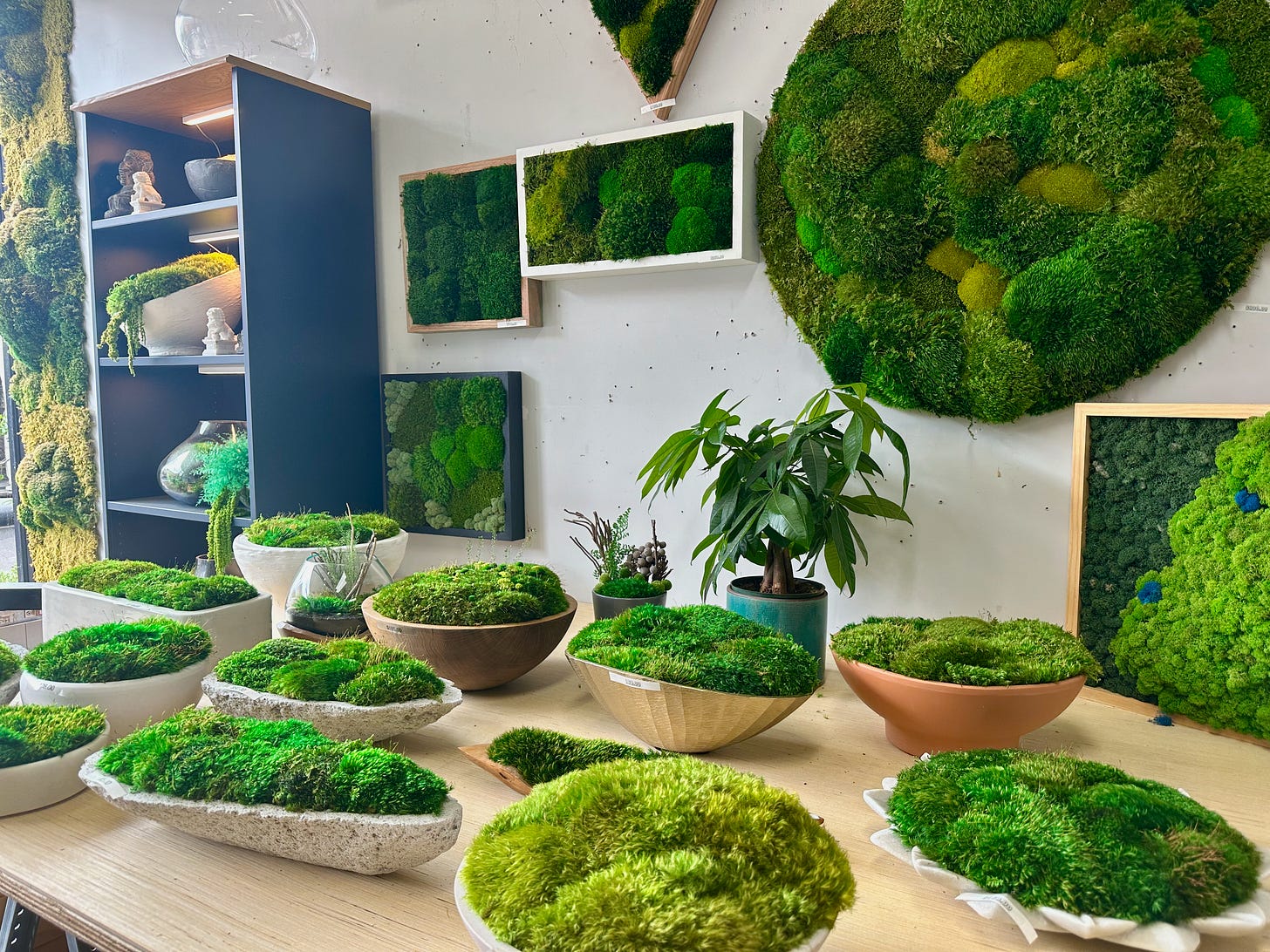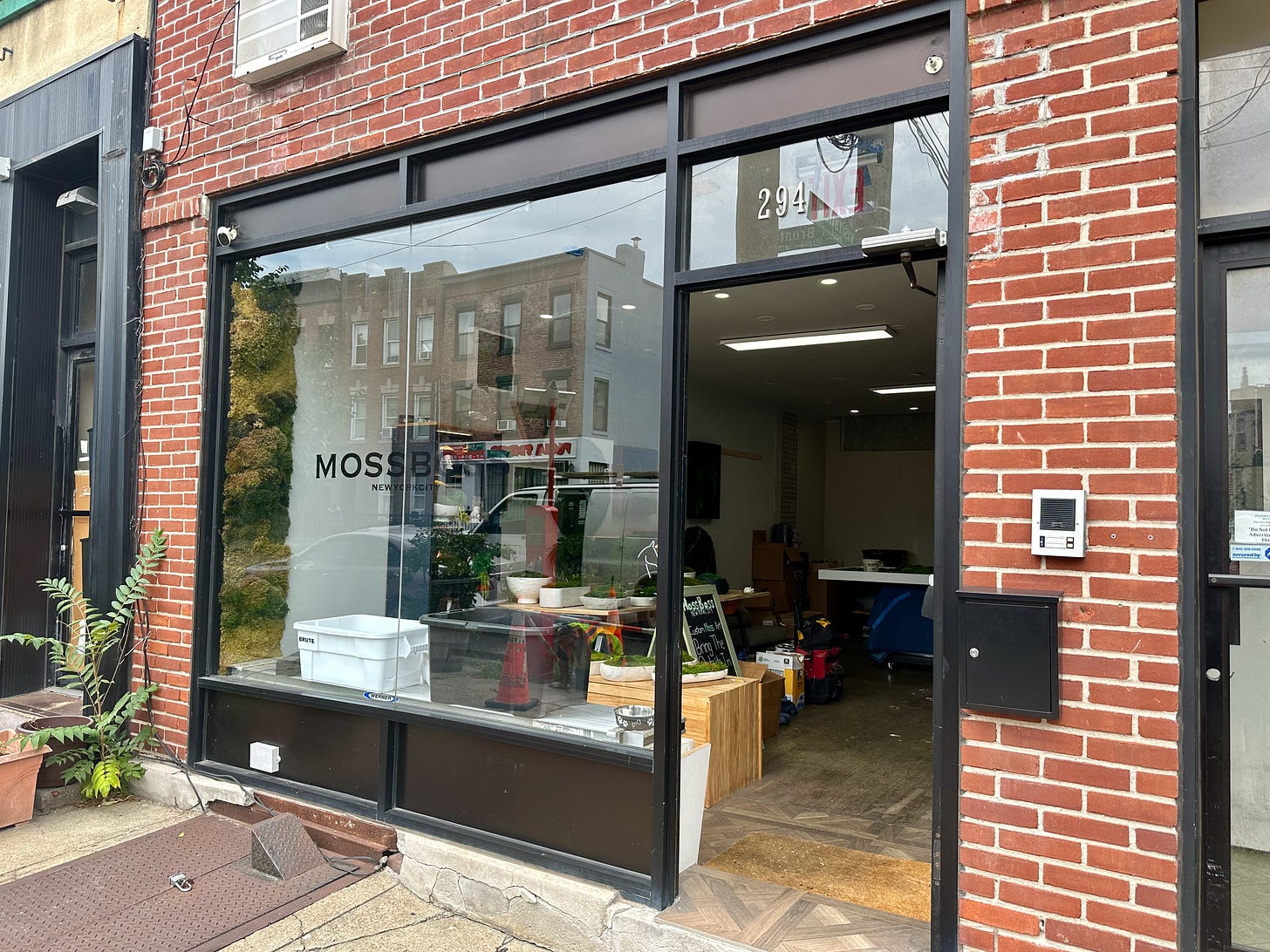Hello everyone,
Welcome to Issue #85 of CAFÉ ANNE!
Heads up! Next week I am going on my annual summer cabin VACATION in Selkirk Shores State Park, a beautiful location on Lake Ontario overlooking the Nine Mile Station nuclear power plant.
That means no newsletter for a couple weeks. The café reopens Monday, September 4 AKA Labor Day. I will miss you!
In other news, huge Shark-Attack-at-Rockaway-Beach shoutouts to new CAFÉ ANNE paid subscribers Jesse S., E.L. Paolucci, Vincent T., Mary L. and Gary V. That’s enough $$$ for five Uber rides from Rockaway Beach to the nearest hospital!
I am very excited about this week’s issue, of course. We’ve a new edition of Eric Adams Watch, some excellent Items of Interest and a visit with Adzi Jasari who recently opened a moss shop in Brooklyn.
Regards!
Anne
ERIC ADAMS WATCH
On Haters, Waiters and the Homeless
I continue to enjoy the exploits of Eric Adams, whom my friend Aharon refers to as “New York City’s first AI-generated Mayor.” As a profile in Politico put it, “In a city of weird people and weird mayors, Adams is maybe the most idiosyncratic figure to ever hold the office.”
Here, round-up #18 of the mayor’s doings:
July 24: At a Midtown press conference, a heckler lets loose: “F— Eric Adams! F—you, a—hole!" The mayor’s curious response: “She said I'm messing with homeless people, you know that? One should be happy if someone wants to make love to them!" No one knows what to make of this strange statement. On Twitter, @cliddle in Tucson wonders, “Why can’t you people elect normal mayors?”
July 24: Later that same day, the Mayor tweets, somewhat cryptically, “Earlier this year you heard my message: More dolphins, fewer rats—and I'm proud to see we're making progress.” His post includes a “STATE OF THE CITY” graphic featuring a banned rat and a dolphin wearing an “I ❤️ NY” teeshirt. One can only hope it will become the official city seal.
August 1: Addressing the issue of hecklers, the Mayor declares, at a press conference, “All my haters become my waiters when I sit down at the table of success.”
August 10: Talk show host Gayle King asks the mayor why he spends so much time partying at his favorite club, Zero Bond. His response: “I've got to boost a multi-billion-dollar nightlife industry that was dying through Covid!”
FEATURE
The NYC Store That Only Sells Moss!
Because it has a zillion residents, New York City has always managed to support a slew of strange shops that sell only one thing. We have entire stores dedicated to selling umbrellas, rubber stamps, hot sauce, feathers, chess sets, chop sticks, typewriters, accordions, pickles, pencils, salt and used cash registers.
And does anyone remember Empire Mayonnaise, in Prospect Heights—a store devoted entirely to peddling a single brand of artisanal mayo?
I thought I'd seen it all until I was walking through Red Hook recently and spotted MossBoss, a shop dedicated to selling moss.
"We specialize in moss. We don't sell anything but moss," said owner Adzi Jasari, when I returned last week to get the story.
"We don't sell plants," he continued. "You can go to any store and find plants. So we stay away from that. It's not my forte. I kill plants. That's why I do moss! Because it's already dead."
Mr. Jasari, who opened his Brooklyn store to the public in June, specializes in preserved moss. Prices on moss planters, wall hangings and terrariums start at $60.
Preserved moss looks like regular moss, Mr. Jasari explained, but the sap has been extracted and replaced with a sugar compound, which keeps it lush and green for years.
"It's almost like embalming!" I said.
"Almost," said Mr. Jasari.
Moss is a great alternative for folks in NYC, said Mr. Jasari, because many residents live in tiny, dark apartments. "We create wall art that brings greenery into the apartment without actually taking up floor space or counter space," he said.
Best of all, you can't kill it! Preserved moss doesn't need sunlight or water—just an occasional dusting. Mr. Jasari whipped out a feather duster and demonstrated his technique on a $120 planter.
While there are more than 10,000 species of moss, Mr. Jasari sticks with six varieties that are readily available from wholesale moss suppliers including spongy deer foot moss, olive green pillow moss and sheet moss.
He buys the moss from two dealers—one in France, one in Florida. Both wholesalers gather moss in the wild, foraging on private lands.
"The one in France, they have an older gentleman that runs into the Alps and collects all their pillow moss," said Mr. Jasari.
Cheaper, farm-raised moss is available from dealers in China, he said. But it lacks the shape and texture variations of moss found in the wild.
A package of moss that covers roughly 18 square inches costs about $30. "So it's not a lot," he said. "But when we do a larger piece, it can add up!"
We admired a 4x6-foot wall piece he was creating for a corporate client that will feature the company's butterfly logo rendered in deer foot moss. It will take roughly 30 hours to complete, he said, and cost about $4500.
His creations start with a bed of spray foam to create a contoured back. Then he applies the moss, preserving individual shapes as they come out of the shipping carton.
"We like a more of a natural look and feel, instead of creating patterns," he said. "I take a piece and I'll put it next to something and see if it fits. And if it fits, great. If not, then I'll take another piece. It's like a big jigsaw.”
Whatever he's doing is working. Mr. Jasari gets several custom orders a month from clients ranging from homeowners, dentist offices and a Brooklyn laundromat to American Express, Accenture and JPMorgan Chase.
I asked Mr. Jusari, who is 42, how his younger self might have reacted to the suggestion that someday he’d be selling moss to JPMorgan.
"No way!" he said. "Knowing my 30-year-old self, I don't think I would have thought I would ever do anything else besides MRIs!"
Mr. Jasari, who spent two decades working as an x-ray and MRI technician before he got into Moss, grew up in Staten Island. His folks, immigrants from the former Yugoslavia, worked as janitors.
"I was just a good kid," he recalled. "I was really scared of my parents. You grow up in an ethnic home, they lay the law down pretty hard. So there were no mistakes to be made!"
He's still not sure why he got an associates degree in radiologic technology. "We had a neighbor that was an x-ray tech. I think maybe there was some guidance there," he said. "I think there was a sense of stability and growth in the medical world—that there was always going to be a job. And it worked. It was great. It was fun! Until it wasn't."
He worked in local hospitals including Beth Israel and Memorial Sloan Kettering, and learned a lot from experimenting with MRI image sequences. "It was a lot of trial and error," he said. "You would have to make mistakes to learn something. I think that made me learn that mistakes are okay. I don't think perfection is done the first time.”
"So you were more of a perfectionist before," I said.
"I still am," he said. "It's hard to break that habit! You want things to go right."
"That's weird," I said. "Because with moss, you can't really make a mistake."
"Correct!" he said. "No one knows the difference. The client will never know. But I know the difference. There's times where I'll finish a piece and then a week later, I don't love it. And I'll just start ripping pieces out and start over."
The MRI world had its moments. Mr. Jasari remembers good times drinking barium—a contrast agent—with fellow techs and performing experimental scans on each other. "You can create images that you could never even imagine!" he said. "And watch the colon move, which was really fun. I mean, it's nerdy. It doesn't make sense anyone to else. But to us it was so fascinating."
Fifteen years in the field wore him down, however, especially when he started working in a private medical practice where he was pressured to get patients in and out as fast as possible.
"I just got burned out," he said. "It was hard, watching people get sick. I think as I got older and the people were more and more my age, it took a toll on me emotionally."
"It took a long time to even acknowledge it," he continued, of his growing dissatisfaction. "Sometimes you just keep going. You don't know any better. You don't know if it's you feeling that way, or is this just part of life?"
Along the way, he tried launching several side businesses—an online t-shirt store, an app to help medical students study for the MRI boards, working as a personal trainer. Nothing clicked, and it was hard to moonlight on top of working 50-hour weeks as a medical technician.
In 2017, he took a sabbatical, and a friend invited him to go hiking in Scotland. "Scotland would have never been on my radar to visit," he said. "But I was like, 'Okay!'"
And that's when he saw it. All over Scotland: Moss!!
"It was everywhere," he said. "And it was lush, and it was green. I couldn't stop seeing it. For some reason I was drawn to it. I can't explain it. Growing on rocks, on trees, on fences. We went to a botanical garden, and there was a whole moss garden. My mind was blown!”
As soon as he got back to New York, Mr. Jasari started making moss art. Friends saw his creations and demanded their own. Soon he was selling at craft fairs around the city, hauling dozens of planters and wall hangings in his SUV. The fair booths cost hundreds to rent and he'd sometimes sell just a single, $25 piece over the weekend.
"But it was worth it to you—you kept going," I observed.
"Yes, it was fun," he said. "There was a sense of joy that came from creating, that I'd never felt before. And figuring it out—which was exciting. I had to teach myself everything. And I still get that kind of spark in me, when I can figure something out that I didn't know."
When the shows led to requests for custom installations, he rented a small studio at a Red Hook co-working space and cut back to working part-time at his MRI job. He spent three twelve-hour days at work every week so he could devote the other four days to moss.
When the pandemic hit in 2020, he was temporarily furloughed from his medical job—and never returned.
"I stared getting more orders during the pandemic than I normally did," he said. "And I was like, 'This might be a good opportunity to keep going. Maybe I don't have to go back.' I just went full force into marketing more, and focusing on the business. It was scary!"
The hardest part? Telling his parents he was quitting the medical field.
"I'm still scared of them!" he said. "I think we all want approval, right? You want to make them proud. You don't want to disappoint them."
They've since come around, which is gratifying. But mainly, he's thrilled to be working a job he created himself. When the pandemic ended, he rented his own storefront studio on Van Brunt Street—it shares the block with a laundromat, an auto repair shop and a lobster joint selling $32 lobster rolls—so typical for Red Hook!
And this summer, he opened the shop to retail customers. He’s just making it up as he goes along, he admits. But there's lots of weekend foot traffic, and folks come in to buy housewarming gifts. He also throws corporate and private moss parties where he teaches folks how to build their own moss terrariums.
I asked his advice for people feeling stuck in their jobs.
"Try everything!" he said. "You may not like it. But at least you’ll know what you don't like. So it doesn't matter what it is. You don't know what you don't know. You don't know what you like, unless you try it."
"Everyone is always asking, 'How do you do it?'" he added. "I'm like, 'There's always going to be failure. I'm not afraid to make a mistake or fail.’”
"Maybe because you'd already failed three times!" I said.
"Maybe," he said. "But I also look at it like, 'What's the worst-case scenario if I do fail? My ego gets hurt? No one's dying. I'm not losing anything!’"
ITEMS OF INTEREST
Just Another Day Commuting in New York City
Restaurants With the Most Brothers
Guy Riding a Citibike With a Couch On His Head
Sam Silverman’s Five Most Unhinged Ways to Prepare a Bagel
CAFÉ ANNE is a free weekly newsletter created by Brooklyn journalist Anne Kadet. Subscribe to get the latest issue every Monday!




















I don't know if this is weird to admit, but I am a fan of moss. I would love to visit this store. Did you know there is a Japanese mascot, Marimokkori, who is a moss ball? With... balls. As in testicles. I wrote about him because I love him and my mum read my newsletter and told me not to write about moss balls again, ha ha ha
Nobody in Arizona should be complaining about other city's politicians.